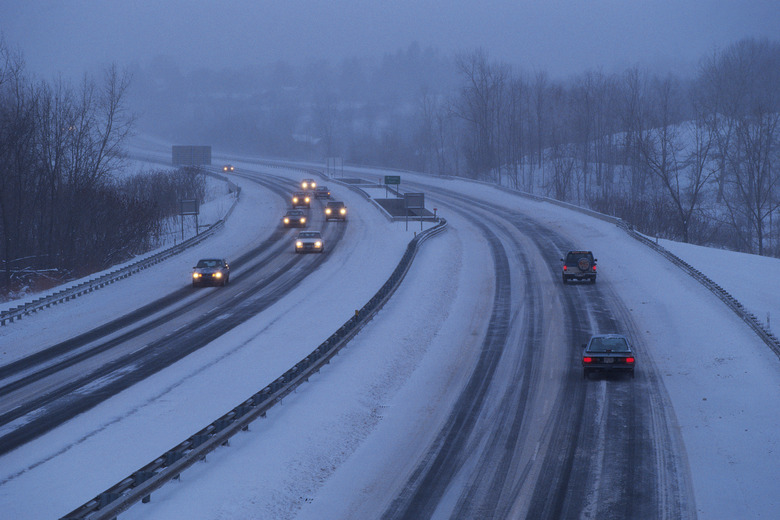The Effect Of Road Salt On The Environment
Before 1938, travel on snowy U.S. highways was difficult because deicing agents weren't used. In that year, New Hampshire experimented with applying salt to roads to lower the freezing point of water, reducing ice formation. The successful practice spread. Up to 20 million tons of salt are now used each winter. Inexpensive, effective, and easy to apply, salt seemed the answer to decreasing winter road hazards. However, since salt dissolves easily in water, it gets carried away and harms the environment.
Buildup in Water
Buildup in Water
Road salt, or sodium chloride, consists of 40 percent sodium ions (Na+) and 60 percent chloride ions (Cl-). These ions dissolve in runoff water from melted snow and ice, and accumulate in streams, rivers, lakes and groundwater. Natural processes don't filtered out or remove ions, so if not sufficiently diluted with water, they build up. Since saltwater is denser than freshwater, it sinks to the bottom, harming aquatic plant and animal life. When salt reaches more than 250 mg/liter in groundwater, the taste and odor become problems. In New Hampshire between 1983 and 2003, more than 424 private wells needed replacement due to salt contamination. (see Reference 2)
Plants and Animals
Plants and Animals
Plants growing along highways often show signs of salt damage, such as brown foliage, poor growth and even death. As salt moves into adjacent areas, it causes dehydration in plant roots and leaves, interferes with nutrient uptake, and negatively affects seed germination. Native plants can be replaced by invasive salt-tolerant weeds. Aquatic animals can be harmed by salt. Wildlife such as deer and moose regard road salt as a salt lick and visit roads to eat, resulting in highway accidents and dead animals. Birds pick up salt crystals as they would seeds, which can cause poisoning and death.
Release of Other Chemicals
Release of Other Chemicals
The anti-caking agent sodium ferrocyanide is added to some road salt. When dissolved sodium ferrocyanide is exposed to sunlight, it can release about 25 percent cyanide ions. This compound joined the list of the Environmental Protection Agency's toxic pollutants in 2003. As salt moves into soils, it interacts with other ions already present, causing release of calcium, magnesium and potassium as well as potentially toxic metals into groundwater. This can deplete soils, leading to lower pH and lessened fertility. It also inhibits growth of soil bacteria. Road salt can also contain other compounds such as aluminum, lead, phosphorus, copper, zinc and nickel as impurities.
Options and Alternatives
Options and Alternatives
Alternative deicers are other mineral salts containing chloride ions, such as calcium chloride, magnesium chloride and potassium chloride, but these are more expensive and have environmental effects similar to salt. Some areas alternate these with salt applications. Organic acetate-based deicers include potassium acetate and calcium magnesium acetate. They have fewer environmental effects, but are more expensive and consume oxygen as they decompose, causing oxygen depletion in water. Recently developed compounds combine sugar with salt for effective deicing. Some states use best-management practices that lessen the amount of salt applied, including pre-wetting the salt, applying it early in snowfall and more precisely based on weather conditions and most dangerous road areas.
References
- Carter Ledy & Milburn LLP: Environmental Impact of Road Salt and Deicers
- New Hampshire Department of Environmental Sciences: Environmental, Health and Economic Impacts of Road Salt
- Cary Institute of Ecosystem Studies Special Report: Road Salt: Moving Toward the Solution
- United States Environmental Protection Agency: What You Should Know About Safe Winter Roads and the Environment
- National Center for Biotechnology Information: National Library of Medicine: National Institutes of Health: Environmental Health Perspectives: Transportation: De-icers Add Sweet to Salt
Cite This Article
MLA
Csanyi, Carolyn. "The Effect Of Road Salt On The Environment" sciencing.com, https://www.sciencing.com/effect-road-salt-environment-9295/. 24 April 2017.
APA
Csanyi, Carolyn. (2017, April 24). The Effect Of Road Salt On The Environment. sciencing.com. Retrieved from https://www.sciencing.com/effect-road-salt-environment-9295/
Chicago
Csanyi, Carolyn. The Effect Of Road Salt On The Environment last modified August 30, 2022. https://www.sciencing.com/effect-road-salt-environment-9295/
